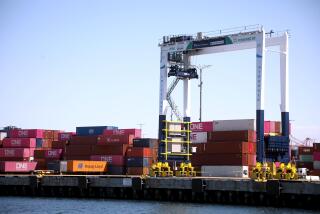Clean energy already jolting job markets
- Share via
HEMLOCK, MICH. — While Detroit’s automakers struggle to rebuild their sputtering operations, the key to jump-starting Michigan’s economy may lie 80 miles northwest of the Motor City.
This is the home of Hemlock Semiconductor Corp. It makes a material crucial for constructing photovoltaic panels. And that has turned this snow-covered hamlet into an unlikely hotbed for solar energy.
On Dec. 15, the same week that General Motors Corp. and Chrysler begged $17.4 billion from taxpayers to stave off collapse, Hemlock announced a $3-billion expansion that could create hundreds of jobs. It’s a rare piece of good news for this battered Rust Belt state, whose 9.6% unemployment rate is the nation’s highest.
In contrast to Detroit iron, Hemlock’s quartz-based polycrystalline silicon is in such demand that workers in white smocks and protective gear toil around the clock to get it to customers around the globe.
Hemlock has been deluged with applications from idle factory hands such as former autoworker Don Sloboda. The 50-year-old Saginaw resident has been retraining at a local community college for what he hopes is the region’s new engine of job growth.
“It looks like the future to me,” Sloboda said.
Whether clean energy can pull Michigan out of the ditch remains to be seen. But the push is on to retool America with so-called green-collar industries.
President-elect Barack Obama wants to spend $150 billion over the next decade to promote energy from the sun, wind and other renewable sources as well as energy conservation. Plans include raising vehicle fuel-economy standards and subsidizing consumer purchases of plug-in hybrids. Obama wants to weatherize 1 million homes annually and upgrade the nation’s creaky electrical grid. His team has talked of providing tax credits and loan guarantees to clean-energy companies.
His goals: create 5 million new jobs repowering America over 10 years; assert U.S. leadership on global climate change; and wean the U.S. from its dependence on imported petroleum.
“Breaking our oil addiction . . . is going to take nothing less than the complete transformation of our economy,” Obama said during a campaign stop in Michigan’s capital, Lansing, last year.
Americans have heard it before. Every president since Richard Nixon has touted energy independence, yet the goal remains elusive. The U.S. imported less than a third of its crude around the time of the Arab oil embargo in 1973. Today foreigners feed nearly 60% of the nation’s petroleum habit.
Skeptics fear that the president-elect’s Green New Deal will do little but waste taxpayers’ money. The government squandered billions on the Jimmy Carter-era synthetic-fuels program, a failed effort to create vehicle fuel from coal.
Corn-based ethanol -- the latest recipient of fat subsidies -- is loathed by many environmentalists, who say it is an inefficient fuel that gobbles precious cropland and helps to drive up food prices.
Better to let the market decide, not the state, said Donald Boudreaux, chairman of the economics department at George Mason University in Virginia.
“The history of government picking winners in the U.S. is not that grand,” he said. “People instinctively love the idea of green jobs. . . . But there is a lot of mass stupidity out there.”
Renewable-energy proponents such as former California Treasurer Phil Angelides say stupidity would be to stick with current U.S. energy policy, which has turbocharged global warming, super-sized the trade deficit and propped up oil-rich regimes hostile to American interests.
Angelides heads the Apollo Alliance, a coalition promoting clean industries as a means of rebuilding U.S. manufacturing and lessening the nation’s dependence on foreign oil.
“It’s the best path to recovery and the best chance of creating jobs that can’t be outsourced,” he said.
Although Angelides’ organization takes its name from the space program that put Americans on the moon, creating green jobs isn’t rocket science, said Oakland activist Van Jones, author of “The Green Collar Economy.”
Jones said Obama’s proposal to weatherize homes would pay for itself through energy savings while putting legions of unemployed construction workers back on the job. A $100-billion investment in a green recovery could create 2 million jobs within two years, a good chunk of them in retrofitting, according to a recent University of Massachusetts study.
“You can employ a lot of people very quickly with off-the-shelf technology like caulk guns,” said Jones, founder of Green for All, an economic development group. “This isn’t George Jetson stuff.”
No one knows precisely how many green jobs exist in the U.S. economy. Estimates range from less than 1 million workers to nearly four times that. What’s clear is that clean industries have been growing rapidly without a lot of help from Uncle Sam.
Worldwide, investors poured a record $117.2 billion into alternative energy in 2007, according to London research firm New Energy Finance. The costs of wind and solar power are dropping fast.
But the industry slowed in late 2008 as the U.S. financial system imploded. Plunging oil prices and frozen credit markets have derailed a number of renewable-energy projects. Some advocates say U.S. government support is needed to keep the sector moving forward.
That strategy has worked for Germany and Japan: Neither is blessed with abundant sunshine, yet these nations boast more rooftop solar arrays than anyplace else, thanks largely to government subsidies. That has created vibrant domestic markets for solar power and tens of thousands of jobs. Asian and European solar module makers dominate the industry.
The irony, say American solar executives, is that the U.S. was an early innovator. Bell Labs introduced the world’s first photovoltaic device in the 1950s. NASA’s space work advanced the field.
The U.S. “created this technology, but we didn’t value it because [fossil fuel] energy was so cheap,” said Ron Kenedi, an American who is vice president of the U.S. solar operations of Japan’s Sharp Corp., a major manufacturer of solar cells.
“We need to reclaim our birthright.”
Many state and local governments aren’t waiting for Washington.
Tough state mandates to cut greenhouse gases and boost the use of renewable energy have turned California into the nation’s hottest market for solar energy. Installers such as SolarCity of Foster City continue to hire even as the rest of California’s economy stalls.
Pennsylvania used incentives to lure Spanish wind-turbine maker Gamesa Technology Corp. to set up shop in an old steel facility. The company now employs more than 1,000 workers in the state, most of them unionized.
New Mexico is diversifying its mineral-based economy with green technology. Germany’s Schott Solar is building a $100-million plant near Albuquerque and the state is grooming wind power technicians at Mesalands Community College in Tucumcari, one of only a few such programs in the country.
Trained wind workers are in such demand that General Electric Co., a maker of turbines, has promised to hire every Mesalands graduate for the next three years.
Michigan has started its own Green Jobs Initiative to retrain displaced factory workers for careers in renewable energy.
“If we can bend sheet metal for car fenders, we can bend it for windmills,” said Ken Horn, a Republican state representative from hard-hit Saginaw.
A tavern owner, Horn said his regulars had been buzzing about green energy -- a sign that the industry was no longer considered fringe or radical.
Michigan’s brightest renewable stars are in solar. United Solar Ovonic, a major producer of thin-film photovoltaics, operates three manufacturing facilities in Michigan and has two more under construction in the state.
Hemlock Semiconductor is a joint venture of two Japanese firms and Midland, Mich.-based Dow Corning Corp., which owns a majority stake.
It is expanding its rural campus not far from Saginaw and building a plant in Tennessee to produce more polycrystalline silicon -- a semiconductor that allows solar cells to convert sunlight into electricity.
The exacting chemical process begins with the mining of quartz and ends with huge, gray, U-shaped bars of polycrystalline silicon wheeled to an assembly line at Hemlock’s Michigan plant, where they’re broken into small chunks for shipment.
Most of the product is sent to Asia and Europe, where solar manufacturers turn it into the familiar panels seen on rooftops. Hemlock employs 1,400 full-time and contract workers in Michigan and expects to add 500 more in the next few years. The plant operates 24 hours a day, 365 days a week, never stopping, even in a recent blizzard.
Snow and ice couldn’t keep Rich Steudemann from sliding into work on a recent morning. A mechanical engineer with more than two decades in the auto industry, Steudemann jumped at the chance to join Hemlock last fall as a quality-control expert.
“This is like the era of Henry Ford,” said Steudemann, 45. “This industry is just starting to take off.”
--






